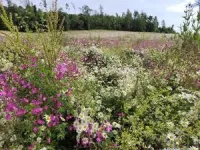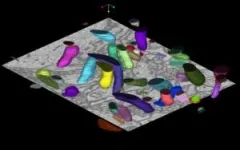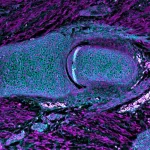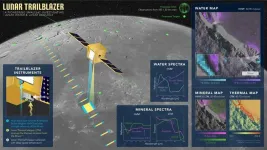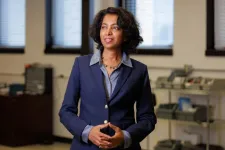(Press-News.org) How can the loss of species and habitats in agricultural landscapes be stopped? Up to now, measures have mostly been implemented by individual farms. In contrast, agri-environmental measures that are planned across farms at landscape level offer greater potential for creating suitable habitats for different species as a mosaic in the landscape. However, successful landscape level approaches also require cooperation between farms and other stakeholders from local governments, politics and nature conservation. Researchers at the University of Göttingen have therefore identified essential key factors that facilitate successful agricultural-environmental collaboration at landscape level. The results of the study were published in People and Nature.
The study is based on the “Kooperativ” project of the Universities of Göttingen and Rostock and the Landvolk Northeim-Osterode. 41 farmers have planted perennial flowering areas on a total area of 250 hectares in 31 landscapes, which not only serve as a habitat for species in the agricultural landscape, but also promote habitat connectivity. “Collaboration makes it possible to achieve ecological effects on a much larger scale than is possible through individual measures,” explains project leader Professor Catrin Westphal from the Functional Agrobiodiversity and Agroecology Group at the University of Göttingen. From the project experience, the researchers have identified three key factors for the long-term success of such initiatives: Bridging structures, i.e. round tables, are essential for the exchange of ideas; regional coordinators – so-called facilitators – network those involved and provide support with agricultural expertise; taking needs such as simplified administrative processes and financial incentives into account increases motivation.
The benefits of the project go far beyond biodiversity conservation in agricultural landscapes. The close collaboration also strengthens social interaction in rural regions: “Farmers really appreciate the fact that they can actively engage in dialogue with the local population,” emphasises Dr Stefan Schüler from the same group, coordinator of the Kooperativ project. “At the same time, bridges are built between different interest groups, which strengthens mutual trust and understanding.”
Kooperativ is funded by the Federal Agency for Nature Conservation with funds from the Federal Ministry for the Environment, Nature Conservation, Nuclear Safety and Consumer Protection as part of the Federal Programme for Biological Diversity. It is regarded as a flagship project for transdisciplinary cooperation and implementation of agri-environmental measures at landscape level and shows how local initiatives can become European role models if they are based on collaboration, trust and shared responsibility.
Original publication: Stefan Schüler et al. Initiating agri-environmental collaboration at landscape scale requires bridging structures, regional facilitators and addressing the expectations of actors. People and Nature (2025). DOI: 10.1002/pan3.10782.
Contact:
Dr Stefan Schüler
University of Göttingen
Faculty of Agricultural Sciences
Functional Agrobiodiversity and Agroecology Group
Grisebachstraße 6
37077 Göttingen
Email: stefan.schueler@uni-goettingen.de
Internet: www.uni-goettingen.de/kooperativ/project
END
Successful strategies for collaborative species conservation
Researchers at Göttingen University show keys to nature conservation measures at landscape level
2025-02-25
ELSE PRESS RELEASES FROM THIS DATE:
Immune cells may lead to more Parkinson's cases in men
2025-02-25
LA JOLLA, CA—Scientists at La Jolla Institute for Immunology (LJI) have found a potential new target for treating Parkinson's disease. Their new research reveals how a protein in brain cells may drive Parkinson's onset—and offers a possible explanation for why Parkinson's is much more common in men.
In recent years, LJI scientists have found increasing evidence that autoimmunity plays a role in the onset of Parkinson's disease. Their recent study in The Journal of Clinical Investigation shows that PINK1 appears to mark ...
SCAI publishes expert consensus on alternative access for transaortic valve replacement (TAVR)
2025-02-25
WASHINGTON—The Society for Cardiovascular Angiography & Interventions (SCAI) has published an expert consensus statement that provides interventional cardiologists, cardiothoracic surgeons, and heart teams with practical guidance for selecting patients and performing alternative access transaortic valve replacement (TAVR).
TAVR has seen substantial growth over the past decade, becoming a standard of care for many patients with asymptomatic aortic stenosis. However, some patients face challenges due to inadequate femoral vascular access. The new guidelines address this gap by recommending alternative access ...
Humans inherited their flexible joints from the earliest jawed fish
2025-02-25
The efficient architecture of our joints, which allows our skeletons to be flexible and sturdy, originated among our most ancient jawed fish ancestors, according to a study published February 25th in the open-access journal PLOS Biology by Neelima Sharma of the University of Chicago and colleagues.
Synovial joints are a key feature of most vertebrate skeletons, providing more mobility and stability compared to other joint types. A synovial joint allows bones or cartilage to slide past each other with the aid of a lubricated cavity between them. These joints are present in land vertebrates and bony fish, suggesting this feature had evolved in the common ancestors of these groups, but ...
Understanding the world within: Study reveals new insights into phage–bacteria interactions in the gut microbiome
2025-02-25
A world of microbes resides within the gut of every human being. This vast microbial community, the microbiome, which includes bacteria and viruses, has repeatedly demonstrated its ability to actively contribute to both health and disease.
Researchers have learned a good deal about the bacterial communities that live in the human gut. For instance, they have discovered that these bacteria extensively metabolize the food we eat, drive normal development of the immune system and, to our detriment, include some opportunistic microorganisms that can cause disease under certain conditions.
On the other hand, the contributions of viruses in the gut microbiome ...
Cold treatment does not appear to protect preterm infants from disability or death caused by oxygen loss, according to NIH-funded study
2025-02-25
WHAT:
Lowering the body temperature of preterm infants (born at 33 to 35 weeks of pregnancy) with hypoxic ischemic encephalopathy (HIE)—a type of brain damage caused by oxygen loss—offers no benefits over standard care, according to a study funded by the National Institutes of Health (NIH). Previous studies of near-term and term infants (born after 36 weeks) with HIE found that this cooling treatment, which lowers body temperature to about 92 degrees Fahrenheit, significantly reduced the risk of death or disability by age 18 months (corrected for prematurity). However, the current findings show ...
Pennington Biomedical researchers uncover role of hormone in influencing brain reward pathway and food preferences
2025-02-25
BATON ROUGE – When faced with multiple food options and ultimately choosing one, the factors of that decision-making process may be more physiological than previously assumed. A group of scientists led by Pennington Biomedical Research Center’s Dr. Christopher Morrison recently discovered that the hormone fibroblast growth factor 21, or FGF21, plays an influential role in brain reward mechanisms like those involved in dietary choices.
The discovery was announced in the research team’s recent paper titled “FGF21 ...
Rethinking equity in electric vehicle infrastructure
2025-02-25
As electric vehicles (EVs) gain momentum in the fight against climate change, the conversation around public charging infrastructure is growing increasingly complex. Xinwu Qian , assistant professor of civil and environmental engineering at Rice University, is spearheading research that reimagines how and where charging stations should be deployed — ensuring that alignment with people’s daily routine and activities, beyond mere accessibility, are at the forefront.
“Charging an electric vehicle isn’t just about plugging it in and waiting — it takes 30 minutes to an hour even with the fastest charger ...
Lunar Trailblazer blasts off to map water on the moon
2025-02-25
On Wednesday 26 February, a thermal imaging camera built by researchers at the University of Oxford’s Department of Physics will blast off to the Moon as part of NASA’s Lunar Trailblazer mission. This aims to map sources of water on the Moon to shed light on the lunar water cycle and to guide future robotic and human missions.
Once in orbit, the spacecraft – weighing 200kg and about the size of a washing machine- will map the surface temperature and composition of the ...
Beacon Technology Solutions, Illinois Tech awarded grant to advance far-UVC disinfection research
2025-02-25
CHICAGO—February 24, 2025—Beacon Technology Solutions (Beacon), with collaborators at Illinois Institute of Technology (Illinois Tech), has been awarded a grant to support a novel study on how Far-UVC technology can help mitigate the spread of infectious diseases in public spaces. The grant was awarded through the Illinois Innovation Vouchers (IIV) Program, which fosters research collaborations between small- and medium-sized enterprises and Illinois’ world-class universities.
Beacon’s flagship product is a wall-mounted smart disinfection device that uses Far-UVC 222nm light, which has been shown to disinfect up to 99.99 percent ...
University of Houston researchers paving the way for new era in medical imaging
2025-02-25
New technology developed by researchers at the University of Houston could revolutionize medical imaging and lead to faster, more precise and more cost-effective alternatives to traditional diagnostic methods.
For years, doctors have relied on conventional 2D X-rays to diagnose common bone fractures, but small breaks or soft tissue damage like cancers often go undetected. More expensive and time-consuming MRI scans are not always suitable for these tasks in these detection or screening settings. Now, Mini Das, Moores professor at UH’s College of Natural Sciences and Mathematics and Cullen College ...
LAST 30 PRESS RELEASES:
Review article | Towards a Global Ground-Based Earth Observatory (GGBEO): Leveraging existing systems and networks
Penn and UMich create world’s smallest programmable, autonomous robots
Cleveland researchers launch first major study to address ‘hidden performance killer’ in athletes
To connect across politics, try saying what you oppose
Modulating key interaction prevents virus from entering cells
Project explores barriers to NHS career progression facing international medical graduates
Jeonbuk National University researchers explore the impact of different seasonings on the flavor perception of Doenjang soup
Two Keck Medicine of USC Hospitals named Leapfrog Top Teaching Hospitals
World-first discovery uncovers how glioblastoma tumours dodge chemotherapy, potentially opening the door to new treatments
A fatal mix-up: How certain gut bacteria drive multiple sclerosis
New AI tool identifies not just genetic mutations, but the diseases they may cause
Deep-learning model predicts how fruit flies form, cell by cell
Combination pills for high blood pressure may simplify treatment, improve long-term health
Immune system keeps mucosal fungi in check
Neurons within the brain use simple rules to localize genetic messages
Electrodes created using light
Second-hand gift-giving is a well-deliberated decision
How human interaction drove evolution to make bears less aggressive
National Poll: Few parents offer teens guidance on healthy eating during holiday season
Cannabis derivatives could provide new ovarian cancer treatments
Raising strong yeast as a petroleum substitute
Clues to the origin of hot Jupiters hidden in their orbits
Canada’s reduced pledge to Global Fund will impact domestic health
1 in 4 children with major traumatic injuries not cared for in pediatric trauma centres
Duke and Duke-NUS’ joint cross-population research to uncover "East-West" differences in disease and care
Scientists to ‘spy’ on cancer- immune cell interactions using quantum technology breakthrough
Tech savvy users have most digital concerns
Making lighter work of calculating fluid and heat flow
Normalizing blood sugar can halve heart attack risk
Lowering blood sugar cuts heart attack risk in people with prediabetes
[Press-News.org] Successful strategies for collaborative species conservationResearchers at Göttingen University show keys to nature conservation measures at landscape level

